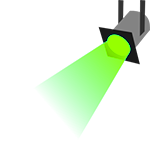
I've been to disco clubs in several countries across Europe (France, Italy, Romania, United Kingdom) and about 10 cities in China.
I have seen a few (very few!) fantastic clubs, lots of average to mediocre ones, and some really bad ones as well.
I have seen some great shows and performances, although it didn't always make me feel like I'd want to come back to the place. Something was missing, or something was off-putting. And well, I've seen too many common and plain mistakes.
This led me to a very clear idea of best practice — a kind of abstract model of the ideal club.
What works. And what does NOT work.
That's why I am writing this right now. To try and diffuse what I feel is the right way to do it, in order to maximise 2 things: 1) enjoyment or, if you will, the amount of sweat on the dancefloor : )) which leads to 2) repeat customers.
So, maybe you're an existing disco/nightclub owner, looking for that special something that seems to be missing from your venue. Maybe you've worked in the business for many years, and the job has become tedious, the nights always feel the same, and the sparkle in your eyes, gone.
Or maybe you're just starting out, looking to operate a venue, or are an investor looking for someone with ideas.
Then hopefully you will find some inspiration in the advice I'm about to give here, and entertain people even more (me included, if I ever visit your club!).
Going further, contact me if you request my engagement to make any of the following points materialise the way I see it fit exactly in my model.
FIRST THINGS FIRST.
Even before starting with the details. The 'why' matters.
Why are you operating a disco venue? If it's to entertain people with music and lights, continue, read on. If it's out of a passion for club music and glamourous dancing, read on.
But if it's just a business, please move on with more lucrative enterprises, or just do another one of those immemorable soul-less venues, and leave the exceptional stuff to someone else.
Oh, and one more thing, deal-breaker kind of stuff; a disco is where at least some customers come to dance. If you only do table-service with no intent of providing a dancefloor, you're not operating a disco but a restaurant with loud music.
So basically if you're not having crazy customers sweat their ass off on a dancefloor, you don't have a disco. Full stop. Everybody, to his own stuff.

So, here goes.
1) Problem: no dancefloor ( ! )
Ok, I don't think everyone really paid attention to what's written just before. So I'll say again, just to make sure. .
NO DANCEFLOOR = NO DISCO
You need to have a dancefloor for people to let themselves go, create dynamics, meet people, get them drinks, etc.
If you have no dancefloor right now, at least clear the center tables and place a platform (with lights maybe), to have people dance in the middle of the room, or in front of the DJ booth.
It's a discotheque, not an opera. It is meant to have people dance, as a way of life. The dancers bring a lot of fun to the place, and attract people to look at them. So please, sacrifice the center table(s) for the greater good of the place.
And allow for circular motion in the room (people should move freely, without being impeded by the tables around). I find that giving too much importance to the tables is not strategic in the long run, as it makes the place "stuffy" and lacking air. Doesn't make me feel like I want to come back there often, if at all.
2) Problem: the volume is too high
You're making your customers deaf, your staff, and yourself. People can't even order drinks properly.
You either need a sound limiter (a piece of hardware), or you tell your DJ to walk around from time to time in order to assess the volume and keep the levels in check so that the loudspeakers don't bloody saturate and it doesn't feel like an outdoor concert.
The reason why this happens is likely the following, and a common trap for inexperienced DJs; they like to put the next track louder than the previous, to top it up and maintain momentum. Fine, but then they forget to lower the volume in the middle of the track! So naturally it quickly escalates, with an ever-increasing volume, and the DJ and everyone is trapped in audio chaos!
3) Problem: the music
The kind of music which the DJ chooses to play at the start of the night (Tech-Trance for example) can be way too powerful. It's awkward to hear high-energy tracks when nobody is warm and the dancefloor is empty.
Once I saw a group of girls leave not long after the beginning of some heavy beats towards the start of the night, as they looked like they just didn't enjoy the music. And as you surely must know, having girls is crucial for a nightclub: they attract the guys.
Another mistake would be to begin with hip-hop; that would send the wrong message by setting this kind of tone. Either you want to have a classy club, or a guetto club.
You can have some melodic RnB for a while at some point during the night.
So, the night has to begin with lower-speed, melodic House music.
I suggest the following sequence (with considerations about lighting as well), structured in phases throughout the night:
a) The 'BEFORE'
House music of type "Before": gentle, not too fast, melodic. Meant to caress people's ears.NO light in the middle of the room (dancefloor).
This might put off some people, but don't worry. The dynamic margin which this creates is going to make them absolutely love the night later on. Don't worry about people leaving. The word of mouth created by the lovers will vastly compensate.
b) The 'WARM-UP'
More engaging, faster House/Dance music. But nothing overwhelming or too energetic, as the goal is not to make people dance (too much) at this stage, but to tease them with blissful and intriguing melodies.Use of smoke on its own (a lot). But still NO light, except for 1 or 2 seconds at a time, to tease...
People will be kept on edge — the tension will build up.
c) The 'LAUNCH'
You need a BIG awesome current music title.Launch of all the lights (after maybe 3 seconds of strobes), at the drop of the big title. This will amaze people to suddenly see the lights in the fob created earlier, in combination with the big music drop.
d) The rest of the night
"If you keep eating sweet stuff, after a while you won't feel the sweetness." Same with music. Dance music shouldn't be kept throughout the whole night, especially at high energy all the time. It will become tedious, sound always the same, and people will become bored and leave.Here, the notion of dynamic margin comes into play.
Ideally, after the LAUNCH, there should be between 3 to 5 Dance sessions, with other types of music in-between (15-20 min), such as Pop, Rock, Disco, RnB, Latino, Oriental, etc. And each Dance phase should have a higher level of energy than the previous: the dynamic margin. So, Electrohouse, Trance, Techno have to wait to be played. These are the big guns. When they come, the shit hits the fan.
This will keep people interested, always wondering what will come next. They will come back to your club every week, if not every day. And become fans of the club.

4) Problem: the DJ keeps to himself/herself
The DJ should look at the crowd, not remain focused on the gear. It's a public performance. Not operating machinery. So the people need to see that the DJ looks at them, and reads them, to see what they want.
The DJ is the one in control of the music, so he is really the one in control of the disco during the night. He is the most important person, and people should be conscious of that. He is the captain taking everyone on a journey, including the staff. The staff has to hum their favorite music tracks (which means the DJ needs to play commercial stuff as well), which will also entice customers.
So that people know who is in charge, the DJ should address the crowd from time to time. Not just the usual "3,2,1 let's GO", but ask people how they feel, call staff by name, say which artist he's playing, or which category of music he's now going to play: "And now we're gonna go into Latino. For the poetic lovers out there...!".
And no other PA guy ("MC") every night as it annoys some people (me included); keep it for some special nights perhaps. The music should speak for itself – with cheerful addresses from the DJ only.
Also, if possible the DJ should use CDs and vinyl records as much as possible, for a more tangible, analogue feel, where people see the DJ choose and spin records before playing them. It is such a contrast in our over-digitalised world.
5) Suggestion: bring the LJ and DJ together in the booth
Lights are very important, and so the Light Jockey and DJ could synchronise better (example: DJ asking for a blackout or strobes in 30 seconds at the break or drop).
The customers would appreciate seeing the LJ being given importance, and seeing the DJ-LJ interaction. And this would be a bit rare to see them together nowadays, so would be original.
Have the LJ dress well (not looking like a computer nerd).
The DJ and LJ should be the only ones in the booth, with the manager coming there at times, and maybe some VIPs/models offered champagne.
6) Suggestion: tactical use of the laser
SLOW moving, and volumetric (rectangle corridor), with smoke to see the shape.
Keep it RARE. People must learn to wait for it during the night, as a precious treat ;-)
Also, fast-moving lasers look cheap. Except if used only once per night maybe, and at the request of the DJ for a very special track.
Don't forget you are operating an indoor venue; it's not meant to have fireworks like some sort of festival. Indoor venues have their own charm and soul. So not too much BANG BANG and dazzle! That's insecure. .
7) Suggestion: gogo dancers
Gogos spur everyone and provide great entertainment value.
There should be min 2 or 3 of them (not a single lost bird, and not a flock of 10 neither for a medium-size venue). 3 passages during the night on podiums. 20-30 minutes each time. Dynamic dancing (not just moving around slowly with the hands down). Doesn't have to be synchronised.
8) Suggestion: door entry fee
At least on Friday & Saturday. Doesn't have to be expensive though. But why count on overpriced alcohol only, keeping everyone at a static table, and/or allow anyone to come and go like it's a windmill?
And that way, the venue becomes precious; a real club.
Flyers with free entry can be given to customers who stay the whole night, and also placed or given strategically in the city by promoters (trendy shops, etc.).
9) Suggestion: special artefact in front of the club / at the entrance
It will make the venue stand out, and it will have an emblem to represent it – which can be used for logos, imagery, marketing, etc.
Think totem animal, famous statue, special character. Keep it sleek and classy.
10) Problem: too many servers/waiters
I've seen sometimes one per table. That's crazy. Why so many? Personally I find it annoying to see too many members of staff around. And these come at a cost.
Also, their uniform/dress code should be simple, classy, and not draw attention (it's not an amusement park).
11) Suggestion: special themed nights
Special themes such as: White, Pink, 80's Disco, 90's Dance, Candy, Robots, Asylum, Phones OFF, Gogo customers...























